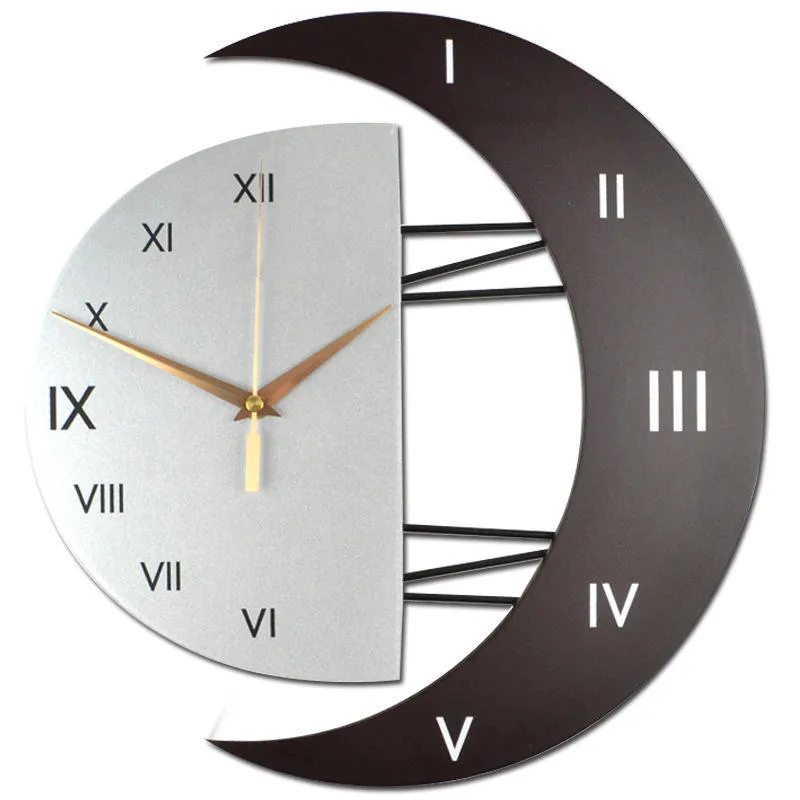Wall Clock Industrial + Purchase Price, Use, Uses and Properties
When you repair a wall clock with an old industrial shape it operates at a quicker speed, and a greater number of pulses are collected, which results in a longer perceived length
Time is the unbroken chain of events that go from the past, through the present, and into the future in what seems to be an unbreakable progression
A person lives in this world inside a period that is represented in the same matter; for example, ten years ago, you were not the same as you are now, neither in terms of your looks nor your knowledge nor your experiences; everything around you changes as time goes on

Time is of critical significance in many aspects of human existence, including the following: Because time is connected to everything that is going on in our immediate environment, we often hear about the time dimension
However, time is also a vital component of existence
Time is a representation of significant life events such as birthdays, anniversaries, and the birth of newborns
It also assists us in the organization of our everyday lives and activities, which enables us to lead a life that is more productive and structured
Everything is entirely reliant on the passage of time, from the moment the sun sets to the moment it rises again, from the height of the tide to its depth, from one season to the next
The Large Industrial Wall Clock is a metal wall clock by Uttermost that has an industrial seeming design
It is made with a cracked ivory face that has rust-red highlights and rustic bronze metal embellishments
Quartz mechanism; batteries are necessary but are not included in the package
This enormous wall clock in an old design appears like it was bought at a flea market and has dimensions of 29 inches wide by 29 inches high by 2 inches deep
One year’s worth of warranty from the manufacturer

The industrial wall clocks have a slick appearance because of their vintage black and industrial color scheme, as well as their golden gears and hands
This clock also has a large number of gears on the right and left sides that smoothly move to create a whimsical impression; if you want to pass the time, you may watch those gears play their game for hours
Wall clock repair
Repair a wall clock in your home because they are a cost-effective way to keep track of time and comes in a wide variety of designs, sizes, and hues, making them suitable for installation in any room of the house or office
They, however, are not exempt from the occasional need for repair, which is something that is easily done with a little bit of knowledge and patience
This is the case with any mechanical operation
The first issue to resolve, which is also the simplest, is to restore the power supplied by the clock’s battery
This can be done by removing the old battery from the back of the clock and installing a new one in its place
If the battery contact points, which are the small metal tabs found inside the terminal, have become corroded, you should be able to clean them by first removing any loose corrosion with a damp paper towel, and then using a little bit of sandpaper to exfoliate any additional material from the contacts

This should restore the battery contact points to their original condition
There are a variety of reasons why, over time, the hands of a clock may require repositioning
There is a possibility that the hands of your clock are touching; in this case, they will need to be adjusted so that the clock can function correctly
The hex nut in the middle may be overly tight; if that’s the case, you should give it a quarter-turn of counterclockwise rotation to loosen it up and make it easier for the hands to move
If the hands tend to get jammed around the six o’clock position, you can make things more secure by pressing the hands firmly down onto the shaft that holds them
Clock hands can also become bent over time, so if your hands are sticky or appear to be pressing up against the plastic clock face, you can manipulate them in the right direction by using your fingers or a pair of pliers
Wall clock industrial
The industrial wall clock is used in a wide variety of settings, including corporations and medical facilities
The majority of applications include radio and television studios, banks, offices, administrative centers, offices, and administrative centers, hotels, companies, shops, airports, railway stations, energy plants, schools and universities, swimming pools, hospitals, sports halls, and gymnasiums

Other typical applications include these places
In the pharmaceutical industry, one of the most fundamental needs for production settings is an accurate display of the passage of time across the various stages of the production process
It is simple to synchronize and integrate with external systems thanks to the fact that it was designed according to the principles of Industry 4
0, and it also can perform actuation
It has a reduced thickness (41 mm), which makes it easily accessible flush to the wall; it is highly resistant to common sanitizing agents, and it indicates hours and minutes in a 12- or 24-hours format plus seconds and dates when in the 6-digit version
The clock is equipped with a large and bright 4 or 6-digit LED display, which indicates hours and minutes in a 12- or 24-hours format plus seconds and dates when in the 6-digit version
When the clock system is connected to Sigma Cloud, it can interface with other systems, such as those that manage access, environmental conditions, video streaming, interlocks, and other factory controls
How to repair wall clock
A typical issue for big fans of wall clocks is how to repair them that keep running faster than they should under normal circumstances
Because there is a simple solution to this issue, you do not need to worry about it
Fixing a wall clock that runs too quickly is often a straightforward endeavor since there are just a few procedures that need to be followed
Instead of hiring a specialist to do the work, an individual may readily accomplish it on their own

If you were to constantly have in mind the possibility of repairing your clock if such a thing occurred, rather than purchasing a new digital clock, it would be of great assistance
Keep the Pendulum in the hand that is not your dominant one
Look for a very little screw at the very point of the Pendulum’s base
The speed of the clock may be adjusted with this screw
To adjust the setting, use the fingers of your dominant hand to turn the regulating screw
By gradually lowering the pendulum and turning the screws to the left, the time on the clock may be slowed down
Two minutes are added to the total running time of the watch for every screw that is turned
Look for a little hole right on top of your clock
There should be one
You may find the phrases “quick” and “slow” printed around the hole to assist you in adjusting the rate at which the clock runs
Put one of the double key’s narrower ends into the hole
Turning the key gradually to the left, or in the direction that is indicated at the top of your clock, will cause your clock to run more slowly
A full revolution of the watch hands takes two minutes off the total time in 24 hours
Several times during the day, compare the time shown on your clock to that of a reliable watch and make any required modifications

Adjust the hands of your mechanical, electric, or battery-operated clock to coincide with an exact timepiece by doing so
Then, during the following twenty-four hours, you should keep a close check on your clock to ensure that it hasn’t merely been mistakenly set
You should move your clock to a different room and then check the time again after it has been there for a full day
There is a possibility that the wall outlet will not provide the required amount of electricity for the clock
If your clock is powered by batteries, you should replace the batteries in it
If, after following these methods, your clock still seems to be beating too quickly, you should get it serviced at an authorized repair facility
The motor may be damaged or faulty, but a professional can swiftly replace or fix it if you bring it to them
Wall clock glass replacement
If the glass on your clock is broken or chipped in any way
You can utilize the glass replacement for the wall clock
Glass wall clocks are a very contemporary take on the traditional form of wall adornment
They exist in a variety of forms and dimensions, and they have the potential to become the primary focus of a room’s design
Everyone will be able to choose a decoration that is a great fit for the style of any given environment if there is a large range of unique prints available to choose from
Glass clocks, in addition to being useful for measuring time, may also be hung on the wall in any space to create an exceptional decorative accent

They are also an excellent decoration in public areas and workplaces and may be utilized to effectively improve the look of many rooms in the house, such as the living room, bedroom, hallway, or kitchen
Their unique and bright prints will enliven the color of any wall, and they will correlate beautifully with any wall decorations you could have
In our inventory, you’ll find vertical glass wall clocks, horizontal glass wall clocks, and square glass wall clocks that measure 30 centimeters by 30 centimeters 30×60 cm
Each of these varieties is constructed out of very durable material and is offered in a diverse range of engaging patterns to choose from
Not only has it resulted in great aesthetic design, but it has also resulted in a high level of robustness for these decorations as a consequence of the care that was given to even the most minute elements
As a consequence of this, they are among the wall decorations that are the most long-lasting
Wall clock replacement motor
If you are thinking about the motor of your wall clock that does not have any replacement, you are wrong
Wall clocks have replaceable components that are readily available at almost all watch and clock repair shops, in addition to several internet retailers
Before making a purchase, it is important to determine if the movement of your clock is of the press-on, or high torque kind so that you can properly search for replacement components
A mechanism-operated wall clock is a clock that operates via a small black mechanism on the back of the clock

This mechanism is either referred to as a clock movement, mechanism, or motor, depending on the context
This mechanism contributes to the accurate keeping of time
A quartz clock, which employs a tiny quartz crystal/oscillator with electrical currents that preserve correct time by pulsating every second, is the most popular form of wall clock that can be purchased today
Quartz clocks are also the most accurate
The mechanism, which is also known as the movement, in a quartz battery clock is much simpler than the movement in a conventional wind-up clock, and the frequency of the quartz battery clock remains stable regardless of the temperature, humidity, or other external conditions
Battery-operated wall clocks preserve highly precise time, as opposed to wind-up clocks, which might lose or gain minutes owing to external circumstances such as variations in temperature
This is because battery-operated wall clocks don’t need winding
The typical lifespan of a clock movement is between ten and fifteen years; however, it is not uncommon for these movements to develop issues and require replacement much earlier than the stated lifespan
If the movement in your wall clock has to be replaced, the process of doing so is often pretty straightforward and calls for nothing more than a replacement movement, some tools, and a watchful eye
Wall clock replacement parts
There are many parts in the wall clock when they out of work you can have a replacement for them
Here are different parts of the wall clock you should know for the time of fixing your wall clock

The gear train that drives a clock is called the Main Wheel
The pendulum or the toothed wheel that spins in the escapement of a clock is referred to as the Escape Wheel
The longer hand that marks the minutes is called the minute hand
Shorter than the minute and second hands, the hour hand indicates the current time
Clock components are housed inside of a case, which is the main body of a clock
The set of bars on the sides of the clock that are used to signify the passing of minutes is called the minutes
The face of an analog clock that displays the hours and minutes using a system of fixed-numbered dials and moving hands
In digital clocks, the time is shown using a digital display
The portion of a clock that displays the various markings for the various units of time is called the face
Hours are indicated by the thicker or more noticeable bars that are located on the edges of the clock and serve the dual purpose of separating the minutes
Clock components are housed inside of a case, which is the main body of a clock

The cylindrical metal box known as the barrel is the component of a mechanical watch or clock that houses both the timepiece’s mainspring and its toothed round gear
The face of an analog clock displays the hours and minutes using a mechanism consisting of one or more fixed-numbered dials and one or more hands that move across the face of the clock
Even in this day and age of digital watches, phones, and other gadgets, it’s still pleasant to have analog wall clocks throughout the home
Quartz is the most frequent movement used in wall clocks; however, they may be found in a wide range of forms, sizes, and designs
When it comes to keeping track of time in the home, the workplace, and places of business-like gyms, and retail shops, wall clocks are often the most cost-effective alternative
Even though repairs and maintenance on wall clocks are normally far less involved, wall clocks still need to be serviced and maintained on occasion









